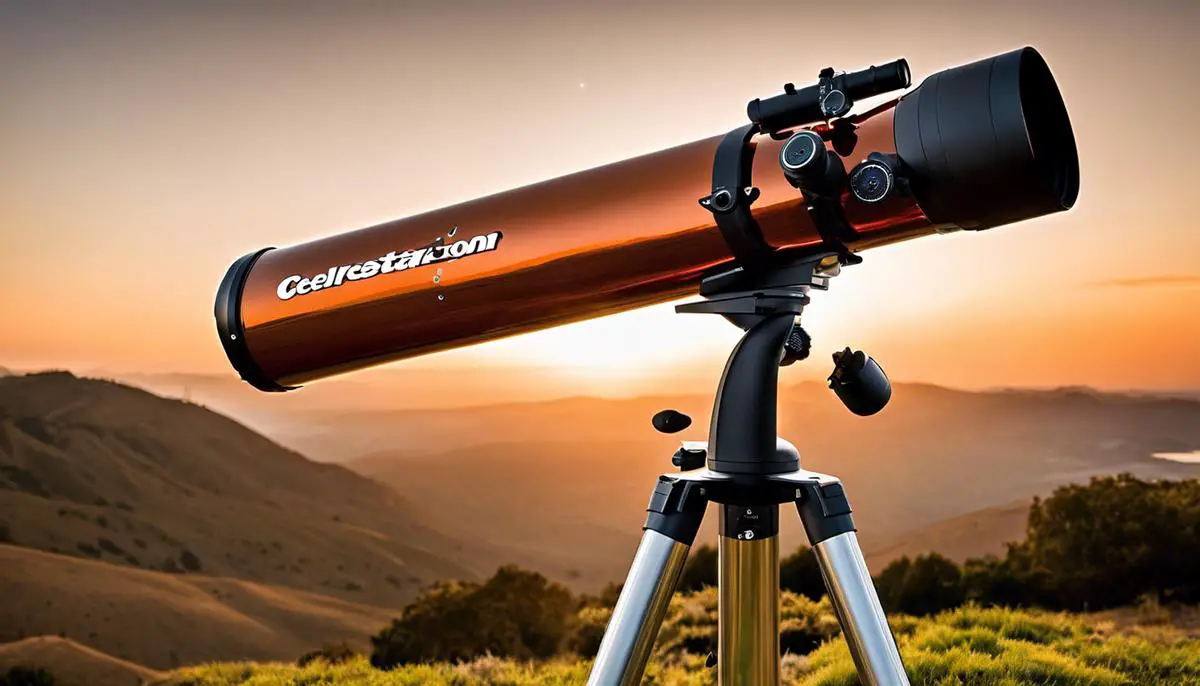Stepping into the universe of planetary observation requires equipment that not only enhances the experience but also brings the cosmos to life with stunning clarity. For those eager to chart the celestial bodies or even offer immersive stargazing experiences, the market boasts a variety of telescopes suited for the task. This essay explores the top-of-the-line telescopes perfect for planetary viewing, each with unique features that cater to the needs of astronomy enthusiasts and entrepreneurial sky watchers alike. From the mighty Celestron NexStar 8SE’s ease of use and superb optics to the market-savvy craftsmanship of the Sky-Watcher ProED 120 APO, these instruments are gateways to the stars, promising unparalleled journeys across the night sky.
Celestron NexStar 8SE Telescope
10 Remarkable Telescopes for Stargazing Enthusiasts Craving Quality Without Complexity
When it comes to stargazing, choosing the right telescope can be as vast and bewildering as the night sky itself. You’re on the hunt for a telescope that balances user-friendliness with high-end features, all without requiring a PhD in astrophysics to use. Look no further; this is your go-to guide for telescopes that deliver stellar views without the fuss.
-
Orion StarBlast 4.5 Astro Reflector Telescope
Price Point: Around $200
Offering superb clarity and ease of use, the Orion StarBlast is a dynamo in a compact design. It’s an ideal entry-level reflector telescope that comes fully assembled for an out-of-the-box stargazing adventure.
-
Celestron AstroMaster 70AZ
Price Point: Around $150
This refractor telescope boasts a quick and easy no-tool setup. The included software gives a celestial education while you observe, making this an astronomical companion that is as informative as it is functional.
-
Meade Instruments Infinity 102AZ
Price Point: Around $220
The Meade Infinity series is renowned for its crisp images of the moon and planets. Its altazimuth mount ensures a smooth viewing experience, perfect for beginners aiming for simplicity without sacrificing quality.
-
Gskyer AZ90600 Telescope
Price Point: Around $260
Featuring a German-technology lens and a generous aperture, the Gskyer telescope breeds clarity with a robust build. Its smartphone adapter allows for easy astrophotography, bringing the cosmos to your social feed.
-
Celestron NexStar 130SLT
Price Point: Around $500
Looking to level up? The Celestron NexStar is a computerized star locating telescope that does the hard work for you. Ideal for those who appreciate technology’s touch in illuminating the universe’s wonders.
-
SkyWatcher S11610 Traditional Dobsonian 8-Inch
Price Point: Around $450
The SkyWatcher combines simplicity with powerful optics. It’s a Dobsonian reflector that offers a large aperture at a modest price, providing bright, detailed images of deep-sky objects.
-
Celestron PowerSeeker 127EQ
Price Point: Around $170
The PowerSeeker series is known for their value, and the 127EQ is no exception. With its equatorial mount for tracking celestial objects, it’s a no-brainer for the budget-conscious yet serious enthusiast.
-
Orion SkyQuest XT6 Classic Dobsonian Telescope
Price Point: Around $330
A telescope that’s as serious about astronomy as you are. The SkyQuest XT6 provides a “big telescope” experience with stellar clarity, and it’s surprisingly straightforward to use.
-
Celestron Inspire 100AZ Refractor
Price Point: Around $290
Creative features like an integrated smartphone adapter and a built-in red LED flashlight make the Inspire 100AZ Refractor practical for the modern stargazer. It’s clever, clear, and convenient.
-
Zhumell Z130 Portable Altazimuth Reflector Telescope
Price Point: Around $200
Portability meets performance with the Zhumell Z130. This compact reflector telescope packs a punch with its parabolic mirror and ease of use, making it a favorite among travelers and backyard astronomers alike.
Each of these telescopes has been handpicked for those keen on diving into astronomy without getting tangled in technicalities. Remember, the cosmos has plenty to reveal, and with the right tool, the universe is yours to unearth. Whether it’s a quest for crisp lunar craters or the wonder of a nebula, these telescopes promise to elevate the stargazing experience, blending sophistication and simplicity like the night sky blends stars and space.

Sky-Watcher ProED 120 APO Telescope
When nighttime falls and celestial bodies twinkle brighter than a downtown skyline, nothing beats the anticipation of witnessing the cosmos through a top-tier refractor telescope. Perfect for amateur astronomers and seasoned skygazers alike, an ideal refractor telescope combines quality optics and user-centric design, ensuring stunning planetary views without a color fringe in sight.
Diving into the world of refractor telescopes, the key is identifying a model that offers a hassle-free setup without compromising on the celestial show. Opt for a telescope with an achromatic lens design; it’s the unsung hero behind crisp, high-contrast images. This feature reduces chromatic aberration, ensuring that planets appear as sharp, vibrant orbs against the void of space.
Considering that not all stargazers have the luxury of owning an observatory, portability is paramount. A lightweight frame that supports a quick assembly, alongside a sturdy mount, offers a winning combo for those impromptu star parties or solitary sessions under the sky. Plus, with the added convenience of carrying cases, transitioning from backyard astronomer to field explorer becomes a breeze.
While on the hunt for the best refractor telescope, don’t overlook the significance of the aperture size. A larger aperture gathers more light to unveil the finer details of planetary surfaces. Mars’ polar ice caps and Jupiter’s swirling storms emerge in jaw-dropping clarity, making the investment worth its weight in starlight.
Price, while an essential consideration, shouldn’t become a black hole for the budget-conscious. There are models with reasonable tags that still boast high-end features—think dual-speed focusers for precise control and multi-coated optics that amplify light transmission for dazzlingly bright views.
Now, let’s discuss extras because who doesn’t appreciate a good bonus? Some modern refractor telescopes come equipped with advanced features like go-to technology and computerized mounts. At the touch of a button, the cosmos is delivered to the eyepiece, curated by automated celestial navigation. For those who prefer a guide, find telescopes that align with astronomy apps, transforming smartphones into cosmic encyclopedias.
Lastly, the true charm of a refractor telescope lies within its versatility. Whether it’s a star nearing supernova or a ship sailing on the horizon, these telescopes double as both nighttime beacons into the universe and daylight spies for terrestrial subjects. This dual functionality presents an open invitation: explore both the world around and the skies above.
Equipped with this knowledge, embark on the quest to find the refractor telescope that doesn’t just show the planets but reveals them in their majestic, chromatic aberration-free splendor. From serene Saturn to fiery Mars, every planet becomes a destination, not just a point of light. Choose wisely, and the universe itself turns into a backyard playground, waiting for discovery.

Orion Atlas 10 EQ-G GoTo Reflector Telescope
Embarking on a celestial journey through stargazing can be both transcendent and overwhelming, particularly when choosing the right telescope. The balance between sophistication and manageability is a tightrope walk; however, automation is reshaping the stargazing landscape, bridging the gap between power and simplicity.
In an age where convenience reigns supreme, the automated telescope is a game-changer for astronomy enthusiasts. Imagine having the universe at your fingertips, with automated tracking systems that lock onto celestial wonders and follow them seamlessly across the sky. Automation allows even the most amateur stargazers to embark on a cosmic exploration with the confidence of seasoned astronomers.
For the busy bodies and the tech-savvy, telescopes with integrated databases are a match made in the heavens. With pre-programmed points of interest guiding the motorized mount, there’s no need for exhaustive star charts or complex celestial calculations. A push of a button directs the telescope’s gaze to the jewels of the night sky—be it Saturn’s majestic rings or the craters of our moon.
The convergence of technology and astronomy has yielded telescopes that sync with smartphones, bringing interactivity to stargazing sessions. Apps that map out the cosmos interact with the telescope, offering real-time information and narratives about the observed objects, turning every glance at the sky into an informative escapade. This synergy redefines the stargazing experience, marrying education with entertainment.
Beyond automation, the optical prowess of these telescopes is nothing short of stellar. Crucial to any stargazer’s quest is a telescope’s ability to uncover the veiled secrets of space. A generous aperture captures ample light, unveiling the subtle details of distant galaxies and nebulae, while specialized optics correct aberrations, ensuring crisp and vivid celestial views.
Portability is another cornerstone of these modern telescopes. Compact designs coupled with quick assembly mechanisms mean these wonders are not confined to backyards—they travel with you, be it to remote dark-sky locations or impromptu gatherings under the stars. They unravel a world where every clear night, irrespective of location, holds the potential for a new galactic adventure.
For those with a desire to dip their toes into astrophotography, certain telescopes come equipped with connectors for cameras, fusing the art of photography with the science of astronomy. This opens doors to immortality, capturing ephemeral cosmic moments that span millennia in snapshot souvenirs to cherish and share.
Price, a barrier that often separates the enthusiast from the expert, becomes less daunting with the advent of telescopes that embody both affordability and functionality. Entry-level models are rife with features once reserved for the higher-echelons of astronomy equipment, democratizing skygazing and ensuring that the stars are within reach of all who seek them.
In essence, the automation-enriched telescope is a beacon for those yearning to traverse the night sky without the intricacy that often accompanies such excursions. It’s a seamless blend of manpower and machine intelligence, fulfilling the desires of a hands-off approach to planet watching. Whether for education, recreation, or personal epiphany, these telescopes offer a celestial conduit—simple, accessible, yet endlessly profound.
Embarking on this cosmic sojourn doesn’t require the linguistics of an astrophysicist or the navigation acumen of an astronaut; it simply demands the curiosity to look up and let the automated mechanisms of modern telescopes do the rest. Every star, every planet, every comet that sparks a sense of marvel is now just a selection away, ready to unveil its story, inviting observers to a front-row seat in the grand theatre of the universe.

The cosmos invites exploration, offering endless celestial wonders that both delight the sight and challenge the intellect. Selecting the appropriate telescope becomes not just a matter of personal preference but a strategic decision for anyone looking to dive deeper into the skies or provide a service that elevates the public’s stargazing experiences. The telescopes discussed herein provide an array of options, each outstanding in its right, designed to meet various observational aspirations. Whether for personal enjoyment or commercial ventures, they stand as testaments to human ingenuity and our perpetual desire to connect with the vast universe that surrounds us.
![]()
